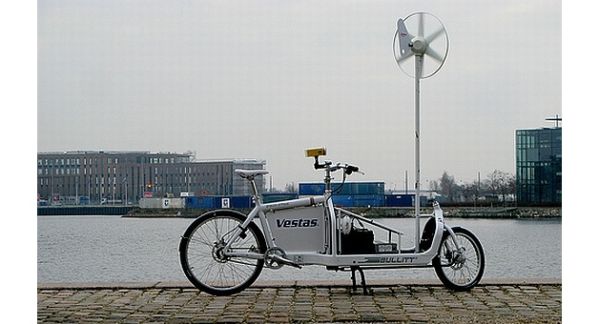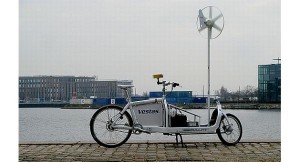
So you pedal an exercise bike at home. That is a good cardio-vascular workout, besides making you feel less guilty about the portion of fries you ate with your burger last evening. Many exercise bikes come with attachments to read your heart rate and and display the calories burnt. The muscular effort is used in overcoming friction in the bike drive and is dissipated as heat. Instead of wasting the the muscular energy as heat, it is possible to convert it into electricity as your contribution to the cause of green energy. The electricity generated will be in the 50 watts to 300 watts range, enough to light a bulb , run a fan or power your laptop but won’t make a significant difference to your utility bill. It is an easy do-it-yourself gadget and is good for a few bragging points with your friends and neighbors.
Generating electricity with pedal energy has been used in the bicycle dynamo to power the bike’s headlamp. The Do-It-Yourself (D-I-Y) electricity bike uses a similar idea to drive an alternator. The power produced in the 30 to 60 minute exercise routine can be stored in a battery and used to recharge the batteries of a mobile phone, music player or laptop computer. When you use these devices through the day, you are reminded that the power is from your muscular energy and you are motivated to return to the exercise regimen the next day.
For a D-I-Y first time project, it is best not to tamper with a pricey exercise bike. Dismantling one may also give you the excuse to avoid exercising. It is best to buy a simple bicycle, perhaps a used or discarded bike. If you can find a geared bike, it is better for the purpose than a single speed bike. Here are the steps to convert this old bicycle into an electric generator.
Difficulty level
This D-I-Y project is only moderately difficult. Once the materials needed have been found, putting it together is quite intuitive.
Time required
Again, once the materials needed have been found, the electricity generating bike can be assembled in about 8 hours of effort
Resources required
1. A used bicycle, geared if available.
2. A metal stand to elevate the rear wheels
3. 2 extension bolts with nuts
4. A car electric alternator
5. A wooden board to mount the alternator
6. A nylon rope
7. A 12 volt, 10 Ah rechargeable battery
8. A 10 Ah Inverter
9. 3 wall socket outlets
Estimated cost
All of the above materials should cost under $ 120. This includes a new geared bike for $40. If you can find a used bike, it should cost less. The other major line items are the battery at around $ 20 and the Inverter at around $ 30.
Instructions
1. The bicycle has a chain and sprocket to drive the rear wheel. The rear wheel needs to be elevated a few inches above the floor level so that the bike remains stationary when pedaled. A sturdy metal stand needs to be fixed to the bicycle for this purpose. Older bicycles had such a parking stand that were hinged around the center of the rear wheel. That stand may not be strong enough to support your weight and remain stable when you pedal hard on your exercise regimen. You can look at attaching two sturdy triangular steel frames to each side connected with extension bolts to the rear center axle. The frames need rubber floor pads to prevent the bike moving about when pedaling and causing the floor to scratch. You can look at some furniture or garden supplies stores to see if you can find one that suits. Else you can get ideas to make one yourself.
2. The choice of the electric generator is the next step. Since the plan is to store the pedal energy in a battery, it is best to look at using a discarded car alternator. In a car, the engine drives the alternator through a pulley and rubber belt. The alternator generates 13 to 14 volts direct current that charges the 12 volt car battery.
In the car, the alternator is mounted on the engine frame. For use with the bike, it is best to mount the alternator on a wooden board that also serves to provide electrical insulation. The voltage is too low to cause electric shock but an insulating board helps avoid risk of water seepage or metal ingress ( such as paper clips) from the floor into the alternator. If the alternator has too may exposed vents, it is useful to add a plastic shield over it made from a plastic bowl or sandwich box. Make some small openings in the plastic cover for air circulation.
The alternator comes with a pulley on it. This is typically a V-groove pulley that takes a rubber belt. To drive the alternator, you need a drive belt between the rear wheel of the bike on its stand and the pulley on the alternator. Since a rubber belt of the size needed would be difficult to get in the market, a belt can be fashioned from a nylon rope, such as the ones used for clothes lines.
3. Remove the tire from the rear wheel, exposing the metal rim. Run the nylon rope over the the rim and around the pulley groove. The pulley and rim should be aligned so that the rope does not slip off the bicycle rim or pulley when the bike is pedaled.
The rope has to be drawn tight over the the bike wheel and pulley so that the rope belt grips the both and does not slip. Remember that the nylon rope will yield a little in use so that it is best to start with a over-tight rope at the start. The cut ends of the rope should be fused together over a flame to make it a continuous circular belt.
4. The generator terminals need to be connected to the 12 volt battery. Sealed maintenance free lead acid batteries are available. You do not need the capacity of a car battery and can instead use the smaller capacity motorbike battery. Battery storage capacity is measured in Ampere-Hours. A 10 Ah battery will deliver 10 Amps of current for 1 hour or 5 Amps for 2 hours. Recharging portable electronics appliances needs much smaller currents and the battery will store enough power for several devices and over many hours. Since your exercise period is likely to be between 30 and 60 minutes, you don’t need a battery capacity higher than 10 Ah.
5. The battery needs now to be connected to an Inverter pack to convert the 12 volt dc output into a 110 or 220 volt ac output that is needed to recharge your portable electronic appliances. Inverter packs are also rated in Ampere-hours and you can buy the Inverter pack to match the battery Ah rating. Wire the Inverter output to one or more wall socket outlets, where you can plug-in your portable electronics for recharging.
Once you have done all the above, you are ready to climb on and start producing electricity.
Frequently asked questions
1. Can I add a heart rate monitor and calorie counter to this bike?
A. These instruments can be expensive. It is now possible to use a smart phone to measure these. Free apps can be downloaded for these functions.
2. Can I connect the inverter output to the home mains?
A. It would be wise not to connect this inverter output to the domestic mains. The electricity generated is too small to make a difference to your utility bills and the risk of a short-circuit are high.
3. What maintenance does this bike need?
A. The system should need no maintenance at all except to check if the nylon rope-belt is slipping and if so to tighten it.
Quick tips
If you are modifying a used bike, it would be good to service the bike first. Essentially check the chin and sprocket for broken links or missing teeth. Clean and grease the bicycle so that the pedals and the wheels work well.
Things to watch out for
The alternator output is 12 volts dc and that needs to be connected correctly to the battery terminals. The positive lead from the alternator to the positive terminal of the battery and the negative lead to the negative terminal. The alternator leads should be color coded and marked. If those markings are not visible, check the polarity with a multimeter. Connecting the leads wrong would short the battery.
Via: ecofriend

 Follow
Follow